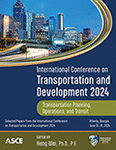Barriers to Community Connectivity: An Assessment of Reconnecting Communities Pilot Program
Publication: International Conference on Transportation and Development 2024
ABSTRACT
Historically, transportation planning emphasized rapid, often more expensive modes like driving, frequently sidelining community preservation and connectivity. Such trends predominantly affected mixed-use urban locales, advancing vehicle-centric designs over the accessibility, quality of life, and economic interests of residents. However, a recent pivot toward transportation equity, as evidenced by the Bipartisan Infrastructure Law (BIL), is notable. The BIL champions, the Reconnecting Communities Program (RCP), an initiative committed to repairing historically induced community separations and promoting accessible, cohesive, and flourishing neighborhoods. This research evaluates the concept of transportation burdening facilities as defined in various studies and synthesizes the existing literature on the methods for assessing barrier effects. Employing data analytics, the study scrutinizes the 2022 RCP awarded applications to discern common patterns in the outcomes of transportation infrastructure that either segregate or impose burdens on communities. This analysis aims to categorize these patterns, which could highlight community severance by pinpointing and addressing divisions caused by previous transportation decisions. Our findings aim to empower decision-makers with actionable knowledge to understand, address, and potentially eliminate such community disjunctions, fostering more integrated and holistic urban planning.
Get full access to this chapter
View all available purchase options and get full access to this chapter.
REFERENCES
Anciaes, P. R. 2013. “Measuring Community Severance For Transport Policy And Project Appraisal” edited by C. A. Brebbia. WIT Transactions on The Built Environment 130(12):559–70.
Anciaes, P. R., S. Boniface, A. Dhanani, J. S. Mindell, and N. Groce. 2016. “Urban Transport and Community Severance: Linking Research and Policy to Link People and Places.” Journal of Transport & Health 3(3):268–77. doi: https://doi.org/10.1016/j.jth.2016.07.006.
Anciaes, P. R., and P. Jones. 2018. “Estimating Preferences for Different Types of Pedestrian Crossing Facilities.” Transportation Research Part F: Traffic Psychology and Behaviour 52:222–37. doi: https://doi.org/10.1016/j.trf.2017.11.025.
Anciaes, P. R., P. Jones, and J. S. Mindell. 2016. “Community Severance: Where Is It Found and at What Cost?” Transport Reviews 36(3):293–317. doi: https://doi.org/10.1080/01441647.2015.1077286.
Emanuele, A., C. Wang, and J. Wainer Katz. 2023. “Past, Present, and Future of Reconnecting Communities.” ArcGIS StoryMaps. Retrieved December 14, 2023 (https://storymaps.arcgis.com/stories/dc61e3bcecd44464b4bfef8299d9d6ce).
Baltimore City DOT. 2022. West Baltimore United;Reconnecting Communities Impacted by US 40.
Bradbury, A., P. Tomilnson, and A. Millington. 2007. “Understanding the Evolution of Community Severance and Its Consequences on Mobility and Social Cohesion over the Past Century.” PROCEEDINGS OF THE EUROPEAN TRANSPORT CONFERENCE (ETC) 2007 HELD 17-19 OCTOBER 2007, LEIDEN, THE NETHERLANDS.
City of Houston. 2022. RECONNECTING COMMUNITIES: Gulfton and Beyond.
Clark, J. M. 1991. “THE APPRAISAL OF COMMUNITY SEVERANCE.” CONTRACTOR REPORT, 135, ISSN:0266-7045 ; (135).
Cline, M. G. 1963. “URBAN FREEWAYS AND SOCIAL STRUCTURE - SOME PROBLEMS AND PROPOSALS.” Highway Research Record (2).
van Eldijk, J. 2019. “The Wrong Side of the Tracks: Quantifying Barrier Effects of Transport Infrastructure on Local Accessibility.” Transportation Research Procedia 42:44–52. doi: https://doi.org/10.1016/j.trpro.2019.12.005.
van Eldijk, J., J. Gil, and L. Marcus. 2022. “Disentangling Barrier Effects of Transport Infrastructure: Synthesising Research for the Practice of Impact Assessment.” European Transport Research Review 14(1):1. https://doi.org/10.1186/s12544-021-00517-y.
van Eldijk, J., and A. Lundberg. 2023. “From Trench War to Dialogue: An Action-Research Study of the Assessment of Barrier Effects in a Transport Infrastructure Project.” Case Studies on Transport Policy 14:101102. https://doi.org/10.1016/j.cstp.2023.101102.
Gbban, A. M., M. Kamruzzaman, A. Delbosc, and S. Coxon. 2023. “The Wider Barrier Effects of Public Transport Infrastructure: The Case of Level Crossings in Melbourne.” Journal of Transport Geography 108:103554. https://doi.org/10.1016/j.jtrangeo.2023.103554.
Hamersma, M., T. Tillema, J. Sussman, and J. Arts. 2014. “Residential Satisfaction Close to Highways: The Impact of Accessibility, Nuisances and Highway Adjustment Projects.” Transportation Research Part A: Policy and Practice 59:106–21. doi: https://doi.org/10.1016/j.tra.2013.11.004.
Handy, S. 2003. “Amenity and Severance.” Pp. 117–40 In Handbook of Transport and the Environment. Vol. 4, edited by D. A. Hensher and K. J. Button. Emerald Group Publishing Limited.
Hansen, W. G. 1959. “How Accessibility Shapes Land Use.” Journal of the American Institute of Planners 25(2):73–76. doi: https://doi.org/10.1080/01944365908978307.
James, E., A. Millington, and P. Tomlinson. 2005. Understanding Community Severance I. Views of Practitioners and Communities. London: The Department.
Jones, S. H., and D. Erian Armanios. 2020. “Methodological Framework and Feasibility Study to Assess Social Equity Impacts of the Built Environment.” Journal of Construction Engineering and Management 146(11):05020016. doi: https://doi.org/10.1061/(ASCE)CO.1943-7862.0001914.
Kaiser, N., and C. K. Barstow. 2022. “Rural Transportation Infrastructure in Low- and Middle-Income Countries: A Review of Impacts, Implications, and Interventions.” Sustainability 14(4):2149. https://doi.org/10.3390/su14042149.
Lara, D. V. R., and A. N. R. da Silva. 2019. “Equity Issues Associated with Transport Barriers in a Brazilian Medium-Sized City.” Journal of Transport & Health 14:100582. https://doi.org/10.1016/j.jth.2019.100582.
Levitt, R. E. 2007. “CEM Research for the Next 50 Years: Maximizing Economic, Environmental, and Societal Value of the Built Environment.” Journal of Construction Engineering and Management 133(9):619–28. doi: https://doi.org/10.1061/(ASCE)0733-9364(2007)133:9(619).
Oklahoma DOT. 2022. Enhancing Community Connectivity in Tulsa: I-244 Planning Study.
Pyrialakou, V. D., K. Gkritza, and J. D. Fricker. 2016. “Accessibility, Mobility, and Realized Travel Behavior: Assessing Transport Disadvantage from a Policy Perspective.” Journal of Transport Geography 51:252–69. doi: https://doi.org/10.1016/j.jtrangeo.2016.02.001.
Russell, J., and J. Hine. 1996. “Impact of Traffic on Pedestrian Behaviour - 1. Measuring the Traffic Barrier.” Traffic Engineering and Control 37(1):16–18.
US DOT. 2022. “Reconnecting Communities and Neighborhoods Grant Program | US Department of Transportation.” Retrieved December 14, 2023 (https://www.transportation.gov/grants/rcnprogram).
Xueliang, Z. 2013. “Has Transport Infrastructure Promoted Regional Economic Growth?— With an Analysis of the Spatial Spillover Effects of Transport Infrastructure.” Social Sciences in China 34(2):24–47. doi: https://doi.org/10.1080/02529203.2013.787222.
Information & Authors
Information
Published In
History
Published online: Jun 13, 2024
Authors
Metrics & Citations
Metrics
Citations
Download citation
If you have the appropriate software installed, you can download article citation data to the citation manager of your choice. Simply select your manager software from the list below and click Download.
